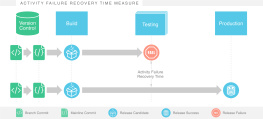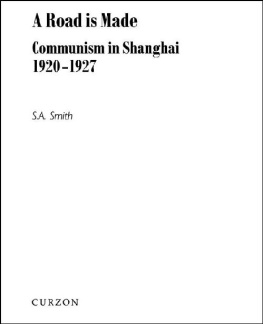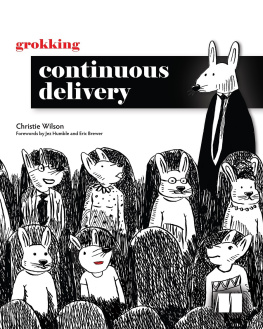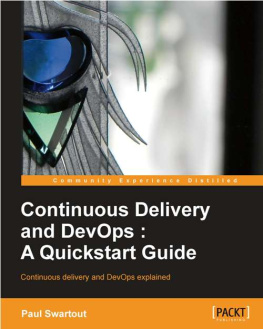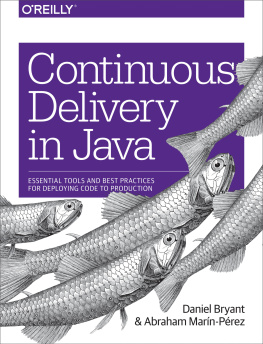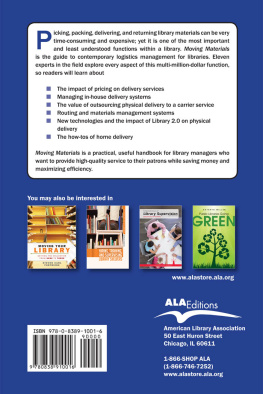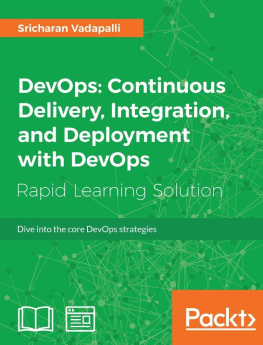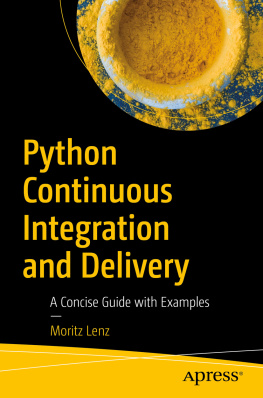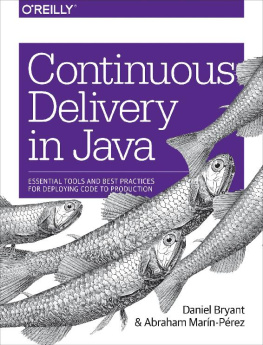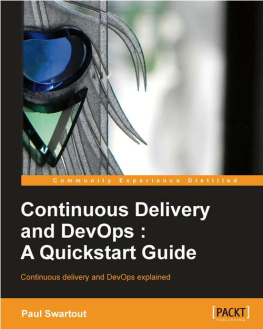Steve Smith - Measuring Continuous Delivery
Here you can read online Steve Smith - Measuring Continuous Delivery full text of the book (entire story) in english for free. Download pdf and epub, get meaning, cover and reviews about this ebook. year: 2016, publisher: leanpub.com, genre: Home and family. Description of the work, (preface) as well as reviews are available. Best literature library LitArk.com created for fans of good reading and offers a wide selection of genres:
Romance novel
Science fiction
Adventure
Detective
Science
History
Home and family
Prose
Art
Politics
Computer
Non-fiction
Religion
Business
Children
Humor
Choose a favorite category and find really read worthwhile books. Enjoy immersion in the world of imagination, feel the emotions of the characters or learn something new for yourself, make an fascinating discovery.
- Book:Measuring Continuous Delivery
- Author:
- Publisher:leanpub.com
- Genre:
- Year:2016
- Rating:5 / 5
- Favourites:Add to favourites
- Your mark:
- 100
- 1
- 2
- 3
- 4
- 5
Measuring Continuous Delivery: summary, description and annotation
We offer to read an annotation, description, summary or preface (depends on what the author of the book "Measuring Continuous Delivery" wrote himself). If you haven't found the necessary information about the book — write in the comments, we will try to find it.
Steve Smith: author's other books
Who wrote Measuring Continuous Delivery? Find out the surname, the name of the author of the book and a list of all author's works by series.
Measuring Continuous Delivery — read online for free the complete book (whole text) full work
Below is the text of the book, divided by pages. System saving the place of the last page read, allows you to conveniently read the book "Measuring Continuous Delivery" online for free, without having to search again every time where you left off. Put a bookmark, and you can go to the page where you finished reading at any time.
Font size:
Interval:
Bookmark:

This book is for sale at http://leanpub.com/measuringcontinuousdelivery
This version was published on 2020-10-31

* * * * *
This is a Leanpub book. Leanpub empowers authors and publishers with the Lean Publishing process. Lean Publishing is the act of publishing an in-progress ebook using lightweight tools and many iterations to get reader feedback, pivot until you have the right book and build traction once you do.
* * * * *
ISBN for EPUB version: 978-1-5272-7743-4
ISBN for MOBI version: 978-1-5272-7743-4
To Rupa, Amara, and Serena

Steve Smith is an IT consultant specialising in Digital Transformation, Continuous Delivery, and Operability. Since 2008, Steve has worked on transformation transformation programmes, in leadership and hands-on roles for public and private sector organisations.
Those roles include creating a deployment pipeline for 8 teams/70 microliths in a media company with 14Bpa revenue, building an operability toolchain for 60 teams/600 microservices in a UK government department with 500Bpa revenue, and creating a Continuous Delivery & Operability strategy for 30 teams/100 microservices in a high street retailer with 2Bpa website revenue.
Steve is a Principal Consultant and Operability Practice Lead at Equal Experts, a worldwide network of technology consultants that specialises in solving complex challenges for enterprise organisations.
Steve is the author of Measuring Continuous Delivery, plus a co-author of A Childrens A to Z of Continuous Delivery and Build Quality In. Steve blogs at stevesmith.tech, chats on Twitter at @SteveSmith_Tech, and is a regular conference speaker.
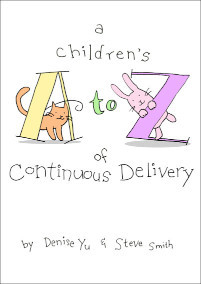
Continuous Delivery is really important, but its also really hard. Denise Yu and Steve Smith thought it would be fun to introduce the best bits of Continuous Delivery, in a medium that everyone can understand. A Childrens A To Z Of Continuous Delivery provide an overview of Continuous Delivery from A to Z in the form of sketchnotes. From A is for Automation to I is for Incremental Deployment and onto Z is for Zzzzzz, youre covered.
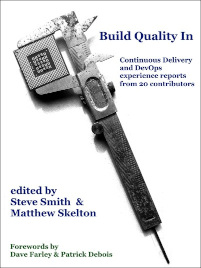
The interdependent disciplines of Continuous Delivery and DevOps are of immense value to an organisation, but they are hard. Steve Smith and Matthew Skelton have seen Continuous Delivery and DevOps work in the wild, and in Build Quality In they want to help people on their own Continuous Delivery and DevOps journey, by sharing the experiences of those who have done it what worked, what didnt, and the highs and lows of trying to build quality into an organisation.
I believe that Continuous Delivery is important to the advancement of software development. Organisations that practice Continuous Delivery dont see five or ten percent improvements in quality and productivity, but usually closer to orders of magnitude improvements.
These are somewhat grandiose assertions, but I do not make them lightly. I believe that software development has seen in recent years a step-change in our ability to create more complex software faster and more reliably than ever before. This is largely due to the practices of Continuous Delivery.
For those of us that have been practising these techniques for a long time, there has been a noticeable change in industry assumptions over the past few years. To a significant degree sequential, waterfall-style processes have been rejected. Even large, complex enterprises that used to strongly defend the need for high-ceremony development processes are attempting to move away from them. This is for a good reason - those approaches dont work very well!
The big web-shops, who were amongst the early pioneers for these more effective approaches to software development, made the change out of necessity. The old approaches, both in terms of technology and process simply did not work well enough at the scale and pace that these new companies needed to move.
Most of us, that I suppose are now seen as pioneers in this field, evolved these techniques empirically. We tried lots of things, often found things that didnt work, but over time refined techniques, processes and approaches that have stood the test of time and are now at the heart of many of the worlds most successful software companies.
I believe that there are good reasons for all of this.
First, the old sequential, planned approaches to software development often fail because they are not based on effective feedback mechanisms. They actively work against the need to reflect, learn, refine, and adapt as we grow our understanding of a problem and our solutions to it.
Second, the new approach to software development is in every sense a change in paradigm. It is challenging because it is so different to what has gone before in most organisations. Organisations will struggle with the transition to these more effective practices as long as they try to hold on to the old ways of thinking.
Third, I believe that Continuous Delivery works because it is based on the application of the Scientific Method to software development. The Scientific Method is humanitys strongest problem solving technique, by far! Science is based on a process of practical, rational, and empirical discovery. We work in ways that build on the work that has come before us, and allow us to learn from our mistakes. The magical thing about an empirical approach to problem solving is that we learn the most at the moment of failure. We organise our process so that these failures are safe, contained, and ideally low-cost. We learn, we adapt, and we move on.
All of this probably sounds a bit philosophical for the foreword about a book on software delivery. However, I believe Continuous Delivery as an engineering discipline is generally applicable to all kinds of software. It is engineering in the sense of the application of scientific methods and knowledge to practical problem solving. We create hypotheses about outcomes, we carry out small changes, we test our hypotheses with low-cost experiments as a falsification mechanism (we refer to many of these as automated tests), we reject changes that do not meet expectations, and we change the direction of our thinking if need be.
This is the Scientific Method in practice, and what does science rely on? Data, facts, and measurements. If we want to be rational in our decision making, if we want to make the highest quality decisions that we can, we need to work in ways that give us insights. This allows us to design new experiments that prove the functional correctness and performance of our software, understand the effectiveness of our teams, and help us learn what our users make of our changes.
Font size:
Interval:
Bookmark:
Similar books «Measuring Continuous Delivery»
Look at similar books to Measuring Continuous Delivery. We have selected literature similar in name and meaning in the hope of providing readers with more options to find new, interesting, not yet read works.
Discussion, reviews of the book Measuring Continuous Delivery and just readers' own opinions. Leave your comments, write what you think about the work, its meaning or the main characters. Specify what exactly you liked and what you didn't like, and why you think so.

